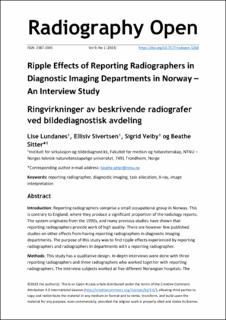| dc.contributor.author | Lundanes, Lise | |
| dc.contributor.author | Sivertsen, Ellisiv | |
| dc.contributor.author | Veiby, Sigrid | |
| dc.contributor.author | Sitter, Beathe | |
| dc.date.accessioned | 2024-04-05T07:20:54Z | |
| dc.date.available | 2024-04-05T07:20:54Z | |
| dc.date.created | 2023-11-13T09:42:18Z | |
| dc.date.issued | 2023 | |
| dc.identifier.citation | Radiography Open. 2023, 9 (1), 27-42. | en_US |
| dc.identifier.issn | 2387-3345 | |
| dc.identifier.uri | https://hdl.handle.net/11250/3124972 | |
| dc.description.abstract | Introduction: Reporting radiographers comprise a small occupational group in Norway. This is contrary to England, where they produce a significant proportion of the radiology reports. The system originates from the 1990s, and many previous studies have shown that reporting radiographers provide work of high quality. There are however few published studies on other effects from having reporting radiographers in diagnostic imaging departments. The purpose of this study was to find ripple effects experienced by reporting radiographers and radiographers in departments with a reporting radiographer.
Methods: This study has a qualitative design. In-depth interviews were done with three reporting radiographers and three radiographers who worked together with reporting radiographers. The interview subjects worked at five different Norwegian hospitals. The interviews took place digitally, and the audio recordings were transcribed before analysis through systematic text condensation.
Results: The analysis showed that radiographers experienced the reporting radiographers as easily accessible, and helpful with questions related to radiographic laboratory work. The reporting radiographers were used a lot for internal teaching in the department and felt that they increased awareness of their own and others' knowledge. They are also being used as a resource outside their own department.
Conclusion: Reporting radiographers have led to increased awareness of level of own knowledge among reporting radiographers and radiographers in the department. The reporting radiographers are acting like a missing link between the radiographers and the radiologists. Besides, their availability leads to more professional discussion and collaboration across different professions and departments. | en_US |
| dc.language.iso | nob | en_US |
| dc.publisher | OsloMet - Storbyuniversitetet | en_US |
| dc.rights | Navngivelse 4.0 Internasjonal | * |
| dc.rights.uri | http://creativecommons.org/licenses/by/4.0/deed.no | * |
| dc.title | Ringvirkninger av beskrivende radiografer ved bildediagnostisk avdeling | en_US |
| dc.title.alternative | Ringvirkninger av beskrivende radiografer ved bildediagnostisk avdeling | en_US |
| dc.type | Peer reviewed | en_US |
| dc.type | Journal article | en_US |
| dc.description.version | publishedVersion | en_US |
| dc.source.pagenumber | 27-42 | en_US |
| dc.source.volume | 9 | en_US |
| dc.source.journal | Radiography Open | en_US |
| dc.source.issue | 1 | en_US |
| dc.identifier.doi | 10.7577/radopen.5268 | |
| dc.identifier.cristin | 2195531 | |
| cristin.ispublished | true | |
| cristin.fulltext | original | |
| cristin.qualitycode | 1 | |

